| Zandbergstraat 14 / 5555 LB Valkenswaard (NL) ☎ + 31(0)651 587 997 Opening hours: Friday and Saturday: 10 till 16 and also by appointment. |
The creation of a non-invasive bamboo hedge. (1 to 4 meters high) Below we present the main three species. These have proven to be the most suitable for a hedge of clump-forming bamboos. A bamboo hedge of Fargesia robusta 'Campbell' |
 |
| (photo above left) Fertilising: Bamboo likes a rich, humus soil. Before planting the soil should be prepared well, for example with homemade compost, old horse manure or compost from the garden centre. Especially on poor soils when you want huge growth these fertilizers may be mixed through the soil in large quantities. After planting the easiest way to fertilize the bamboos is with granular fertilizer like Culterra (photo above right) I5 liter potten of Fargesia robusta 'Campbell' Spacing: one plant per meter or 3 plants per 2 linear meters. If you have little patience 2 plants per meter. The bamboo must be slightly planted lower than the surrounding ground. Planting and watering: Before planting out, the roots should be soaked in water for some time, and after planting it is important that the plant is watered well. Especially during dry periods watering should be done often until the roots make contact with the surrounding soil. Abundant watering from time to time is better than a little water every day. The roots should not dry out and need some time to expand into the soil, but once the plant has rooted well it is much less vulnerable, although it still likes to be watered regularly. Plants that leave the nursery green and healthy and then turn brown within a couple of weeks have nearly always suffered from dehydration. The nursery does not take any responsibility for this. |
 |
| (photo left) Even non-invasive species can grow to big. Rhizome barrier (Root control) of only 30-35 cm can limit the final desired width of the hedge. Fargesia robusta'' Campbell needs a strip that should be at least 80-100 cm wide. (pictured right)) When you plant the larger 15-liter containers of Fargesia robusta 'Campbell' this is the result after 1 to 2 years of growth. 5 liter pots takes one year longer. The growth rate is also dependent on the fertility of the soil. The planting time begins when the frost is out of the ground (usually in late February) and the hardier species you can plant until late fall. The plants are grown in pots and can be planted in principle the entire growing season. |
 |
| (photo left) Results after 3 to 4 years of growth. A 3 to 4 meter high bamboo hedge of Fargesia robusta 'Campbell'. (photo right) This species can also be pruned into a tight hedge, but one must take into account the growth pattern. If the hedge is pruned during the growing season, the new shoots will grow through it again and this may be higher than the original hedge. These should be pruned back to the desired height so that the original shape is restored. The older branches can also still be some top-heavy. If you shorten this culms with ¼ of the length they will stand upright again. For this one needs some hairdresser talent. A bamboo hedge of Fargesia sp. Jiuzhaigou 1 |
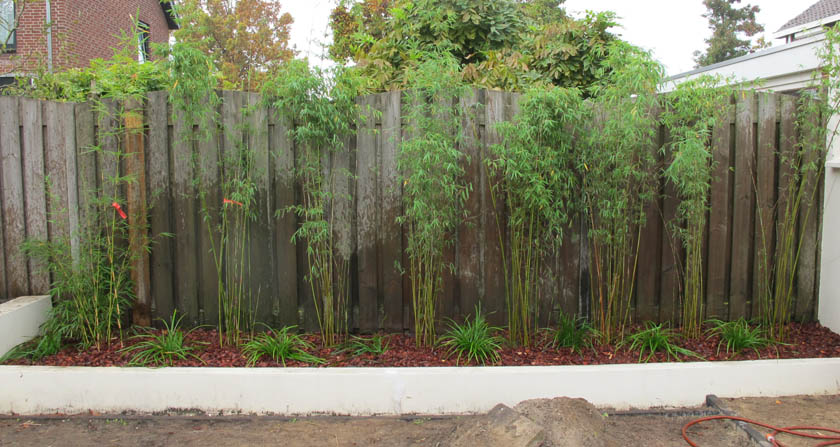 |
| (Photo above) New planting of Fargesia sp. Jiuzhaigou 1 (15 liter pots). Spacing: one plant per meter (preferable) 3 2 plants per linear meters or even faster to get a hedge close two plants per linear meter. Spacing: one plant per meter or better 3 plants per 2 linear meters. If you have little patience 2 plants per meter. The bamboo must be slightly planted lower than the surrounding ground. Watering is associated with planting. Regularly, especially in dry weather. |
 |
| Even non-invasive species can grow to big. Rhizome barrier (Root control) of only 30-35 cm can limit the final desired width of the hedge. Fargesia sp. Jiuzhaigou 1 needs a strip that should be at least 40 cm wide but 80-100 cm wide is better. (photo right) This species can also be pruned into a tight hedge, but one must take into account the growth pattern. If the hedge is pruned during the growing season, the new shoots will grow through it again and this may be higher than the original hedge. These should be pruned back to the desired height so that the original shape is restored. The older branches can also still be some top-heavy. If you shorten this culms with ¼ of the length they will stand upright again. For this one needs some hairdresser talent. |
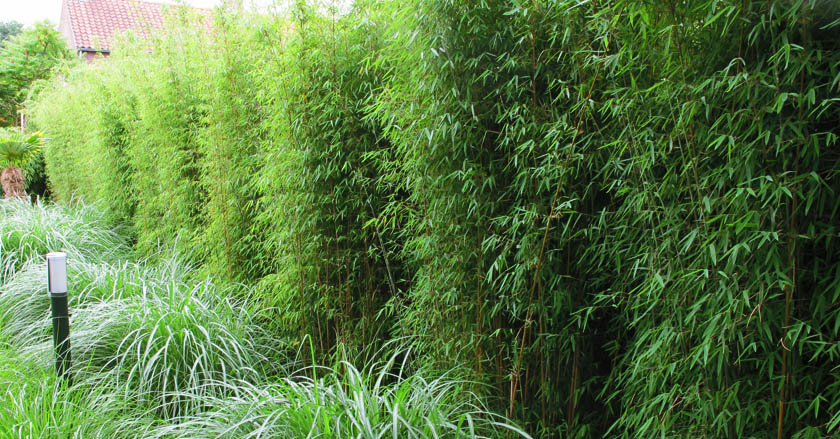 |
| (photo above) Results after 2 to 4 years of growth. A 2 to 4 meter high bamboo hedge of Fargesia sp. jiuzhaigou 1 . A bamboo hedge of Fargesia 'Rufa' |
 |
| photo above) Even non-invasive species can grow to big. Rhizome barrier (Root control) of only 30-35 cm can limit the final desired width of the hedge. Fargesia 'Rufa' needs a strip that should be at least 80-100 cm wide. But the hanging branches of this dense species will become more wide. Spacing: one plant per meter or 3 plants per 2 linear meters. If you have little patience 2 plants per meter. The bamboo must be slightly planted lower than the surrounding ground. |
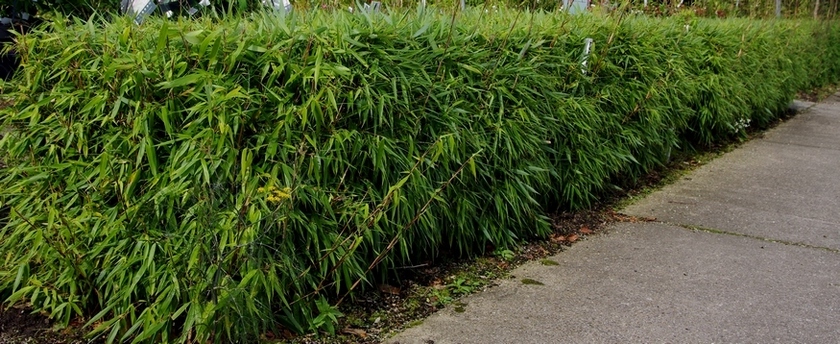 |
| (photo above) Fargesia 'Rufa' can also be pruned into a tight hedge, but one must take into account the growth pattern. If the hedge is pruned during the growing season, the new shoots will grow through it again and this may be higher than the original hedge. These should be pruned back to the desired height so that the original shape is restored . The creation of a higher bamboo hedge. (4 to 10 meters high) |
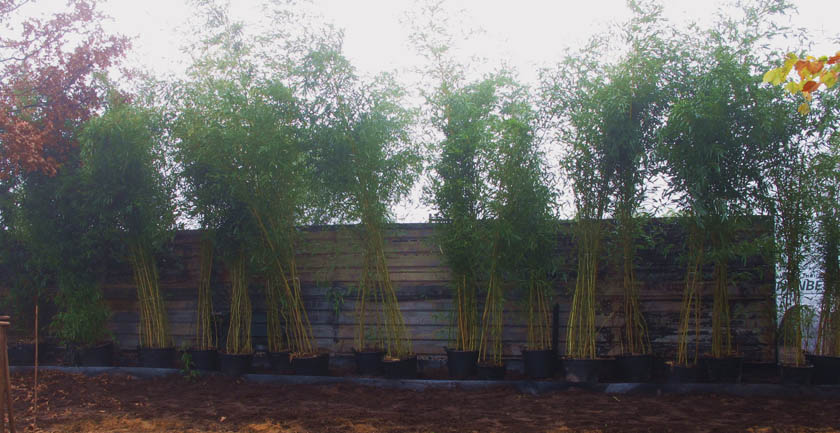 |
| Larger plants of Phyllostachys aureosulcata 'Aureocaulis' before planting. The root barrier has been dug and the soil is fertilized. The plants have the first few months after planting needs. Spacious and regular water The root barrier should be 3 to 5 cm above the crowd and be checked once a year. Watering Before planting out, the roots should be soaked in water for some time, and after planting it is important that the plant is watered well. Especially during dry periods watering should be done often until the roots make contact with the surrounding soil. Abundant watering from time to time is better than a little water every day. The roots should not dry out and need some time to expand into the soil, but once the plant has rooted well it is much less vulnerable, although it still likes to be watered regularly. Plants that leave the nursery green and healthy and then turn brown within a couple of weeks have nearly always suffered from dehydration. The nursery does not take any responsibility for this. |
 |
| Young plants of Phyllostachys bissetii. Because of the growth rate of this type one plant per meter is enough to make a hedge in 2 years. More plants per linear meter is possible. |
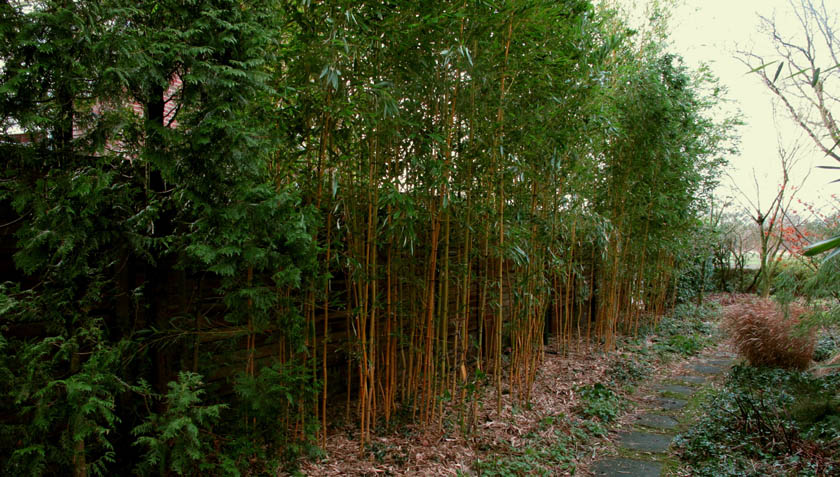 |
| This adult Phyllostachys aureosulcata 'Aureocaulis' hedge is 7 feet tall. The edge of the root barrier is covered with ground cover. The choice between thinning or grow naturally has everything to do with our purpose and also the space we have. If you want to cover an ugly building or neighbor then the grove can't be dense and high enough. In contrast, when you want to see the canes you must prune to creates transparency. |
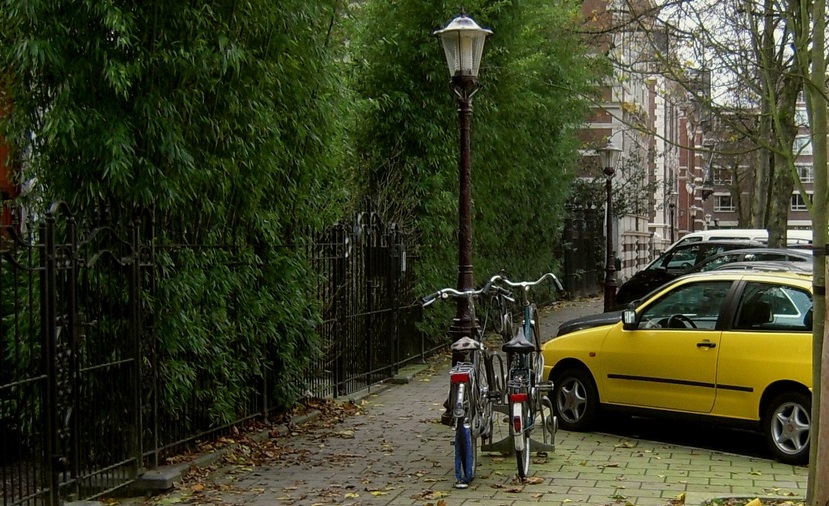 |
| Example of a higher dense bamboo hedge of Phyllostachys bissetii. |
(above) Growth: Most bamboo species have new shoots emerging from April to July and these shoots already have the same girth as they will have two months later when they have grown out to mature culms with full height. Depending on the species these culms reach from 30 centimeters in the case of Pleioblastus pygmaeus up to over 10 meters with Phyllostachys vivax. After growing to full height, the culms develop branches and leaves but don't increase in girth or height. Next year's culms can grow higher and thicker until the plant reaches maturity. Many species have an after growth in autumn, but these culms are mostly thin and crooked and can be cut away immediately. Running bamboos start growing their horizontal rootstocks, or rhizomes, in late summer. Rhizome barrier (Root controle) |
 |
| (pictures above) Works in collaboration with Bamboekwekerij Kimmei and Koert Gardening in Rotterdam Zoo (Blijdorp). In most gardens a barrier is necessary against the rootstocks of running bamboos. This material is for sale at the nursery. At the nursery we sell rhizome barrier 57 centimeters wide. For some types like Semiarundinaria fastuosa we recommend a width of 70 centimeters. This one millimeter thick polyethylene sheet material is impenetrable to the rootstocks, yet pliable and weather-resistant. For a 4 to 7 meters high bamboo we recommend at least two square meters of rich soil, for the real big ones you will need three to five times this size. The rhizome barrier has to be dug in around the bamboo with about two centimeters protruding above the ground to prevent runners growing close to the surface from escaping, but check at least twice a year if the rhizomes stay within the barrier, for they still can grow over the edge. When applied well, this barrier is the safest way to hold a bamboo in its place. By the regular cutting of thin and old culms the part of the plant above ground has to be kept in balance with the roots. |
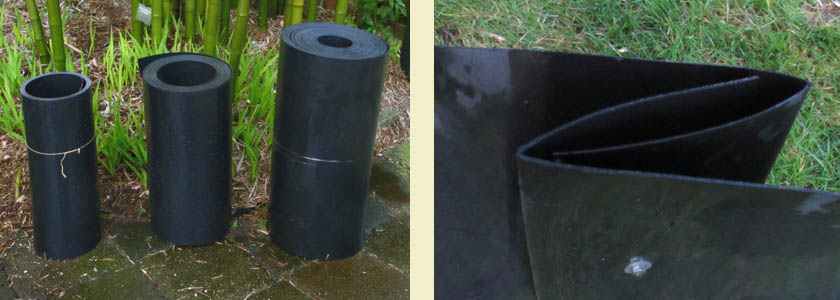 |
A bamboo with 10 to 15 healthy canes on a small space often is more pleasing to the eye than a dense and tangled bush. We cannot give a 100 percent guarantee for the reliability of the barrier because local factors or improper use of the material may fail to keep all rhizomes in. We decline any responsibility for this. Rhizome barrier is for sale at the nursery. 60 centimeters wide: 4.50 Euro per meter. 70 centimeters wide: 5,00 Euro per meter. (inclusive 21% VAT |
 |
| The shape of the planting area. The shape of the planting area is not important, provided that it is not made too narrow (at least one meter wide for the larger species). (Photo left) The incorporation of compost within the root barrier. (pictured right) The planting of Phyllstachys bissetii. It is important that the surface is not too small for the bamboo. |
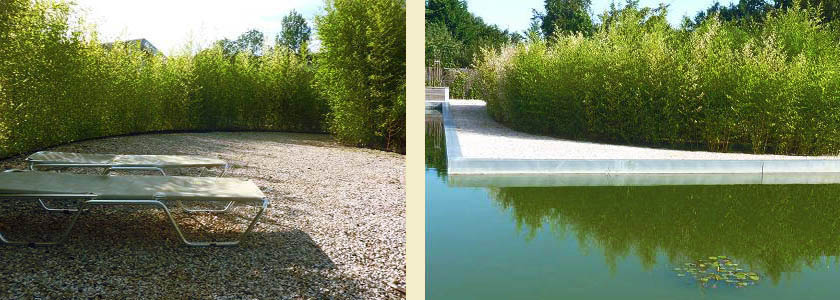 |
| The same Phyllstachys bissetii. Results after 3 years of growth. A full 4-5 meters high hedge. Project in collaboration with Koert Gardening: Spa Wellness Weesp |
General information Planting and watering: Before planting out, the roots should be soaked in water for some time, and after planting it is important that the plant is watered well. Especially during dry periods watering should be done often until the roots make contact with the surrounding soil. Abundant watering from time to time is better than a little water every day. The roots should not dry out and need some time to expand into the soil, but once the plant has rooted well it is much less vulnerable, although it still likes to be watered regularly. Plants that leave the nursery green and healthy and then turn brown within a couple of weeks have nearly always suffered from dehydration. The nursery does not take any responsibility for this. Fertilising: Bamboo likes a rich, humus soil. Before planting the soil should be prepared well, for example with homemade compost, old horse manure or compost from the garden centre. Especially on poor soils when you want huge growth these fertilizers may be mixed through the soil in large quantities. After planting the easiest way to fertilize the bamboos is with granular fertilizer like Culterra There are two types of hardy bamboo, running and non-running species. Winter-hardy and wintergreen: The minimum temperature at which a bamboo keeps its leaves and buds is different for various species. Some are wintergreen to minus 15 degrees centigrade (+5°F) but freeze at minus 18. Others like Fargesia nitida and Fargesia species Jiuzhaigou are only partly wintergreen and curl up their leaves with frost, direct sunlight and low air humidity, but they are hardy to minus 20 degrees centigrade (-4°F) and more. Fargesia murieliae, Fargesia denudata and Fargesia 'Rufa' are usually greener in winter. There are even deciduous yet very hardy species. Some lower bamboos have frost-sensitive foliage, which can be cut off in spring to stimulate fresh new growth. Higher bamboos react similar to cold as do woody plants. To grow to maturity the aboveground part of a plant has to withstand our winters. Not winter-hardy are species that can only survive temperatures at or just below freezing (0 to -8°C / 32 to 18°F) Moderate hardy species can stand -8 °C tot -15°C (18 to 5°F) for short periods. Hardy we call those species that survive aboveground with or without damage to the leaves at temperatures from -15 to -20°C (5 to -4°F). Very hardy species survive temperatures aboveground between -20 and -25°C (-4 to -13°F). Usually the foliage can't withstand these temperatures. |